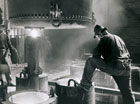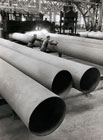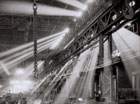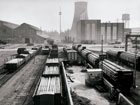The reasons for the Foundation
Governance and the Foundation’s relationship with the company
The staff and external collaboration
Management of the Foundation
 G.P.: What were the needs that led to the establishment of the Foundation?
G.P.: What were the needs that led to the establishment of the Foundation?
S.M.: In the history of Dalmine there is an archives - a patrimony of records and photographs that had been partially reordered before the takeover of the company by Technit Group. When the company was privatized in 1996, one of the first things we noticed was the archives’ precarious condition—so we started a project to safeguard it.
The first three actions undertaken by Paolo Rocca (Tenaris CEO and Chairman of the Dalmine Foundation) following privatization were first, to save the archives; second, to provide it with a headquarters and finally, to enhance the image of the Foundation. Mr. Rocca wanted to recover the history of Dalmine, which intertwined with that of his grandfather (Agostino Rocca) and with Siderca’s history. Our task was to put his decisions into effect, finding the right legal form, the right people and everything else.
G.P.: This means that of business history was already considered to be important and that, after privatization, this process gained momentum.
S.M.: Yes, but probably, before privatization, the attention was solely on Dalmine. After that it shifted to Agostino Rocca’s history as a unifying element in the different backgrounds of Dalmine, Siderca, Tamsa and the Technit Group. Then Tenaris was set up in 2002 and expanded as a company without this unifying element, but … Perhaps the two most important elements were Dalmine’s history as a company and the desire to reconstruct the history of Agostino Rocca, who began as a young technician and ultimately became CEO.
C.L.: If I can add something, the beginning was in the archives itself more than in the interest to develop or systematically rebuild the history; the point is, we had the raw material. For many reasons (also linked to the fact that the years 1990-1995 were not an easy period for Ilva, who controlled Dalmine at that time), there was no systematic initiative to use the archives as a means to promote enduring cultural initiatives, apart from occasional celebrations for the eighty years of the company. To state it simply--before the creation of the Foundation, there was no dedicated structure for this purpose.
S.M.: Well, the Technit Group has always paid attention to the cultural dimension in Argentina, for example, they are involved in several initiatives. Those of us who know the Technit Group are not surprised that work on the archives has broadened and diversified over the years.
G.P.: In any case, the family seems to have a deeply ingrained sense of culture, don’t they?
 C.L.: Yes, and they have been equally attentive to the papers of the archives in the same way that Agostino Rocca himself maintained his own personal archives, which he personally safeguarded, reordered and made available to the public [now deposited at Einaudi Foundation in Turin]. This means that the appreciation of the records as historical memory can be traced directly to Agostino Rocca’s experience.
C.L.: Yes, and they have been equally attentive to the papers of the archives in the same way that Agostino Rocca himself maintained his own personal archives, which he personally safeguarded, reordered and made available to the public [now deposited at Einaudi Foundation in Turin]. This means that the appreciation of the records as historical memory can be traced directly to Agostino Rocca’s experience.
G.P.: His action brings up the question of an entrepreneur’s self-image, as if to say, “I will put my records at the public’s disposal because I am confident about how my life and work will be judged by others”.
S.M.: Yes, but we should also consider a fundamental sense of “data culture”; Agostino Rocca had it, and so did his son Roberto. The data may be economic, numerical, or some other type, but it is a heritage which should be preserved if possible.
G.P.: So it’s a family style.
S.M.: I think so; it began as the style of the family and later become a managerial style. The startup of the Foundation was no surprise to us: in fact, it seemed perfectly logical. And then there is also the story of Dalmine, the mother company that was bought by its successor, the sort of story that doesn’t happen often among people whose lives were connected by both family and business. This was a technological communion that has always gone with the Dalmine to Siderca and Tamsa: these people knew each other pretty well. When Carolina [Lussana] brought us the photographs of the boarding of the pipes that were to be shipped to Argentina to create the famous pipeline of the pampas. So, we were very interested in putting together the pieces of a puzzle whose first stage was completed this year with the books edited for the centenary. 
G.P.: So there was a broad network of relations, acquaintances and trust.
S.M.: Very much so, particularly with regard to the technicians, also because in the world of unwelded pipe, there is a circle of specialists who know each other and have met frequently for professional advice.
C.L.: Moreover, Dalmine in the 1950s was an experience of exporting technology, but also a model of developing a relationship with the territory. This notion became rooted in the Argentina of the 1950s based on the Dalmine model. 
S.M.: That is to say, Agostino’s model. When we went to [Argentina where one of Tenaris companies is set, TenerisSiderca] the names changed over time, but Siderca was established as Dalmine Safta, then Dalmine Siderca and finally Siderca. So the name Dalmine has always been there.
C.L.: The working district of the town of Campana, next to Siderca, has always been called Barrio Dalmine, keeping its link with its industrial origins.
S.M.: And of course, it follows the conceptual pattern; Dalmine built the working district, the managers’ district, the church, the municipality, the swimming pool and so on…
C.L.: the guest quarters…
S.M.: Yes, also the guest quarters.
G.P.: So all this created the premises to make the moment of the meeting easier…
S.M.: Easy and shared by everybody. The idea of reordering of Dalmine’s history made everybody curious: the people of the place who probably did not know much about the development of South American history and the people of Siderca whose knowledge was somewhat sketchy. So, even if the presence of a cultural foundation in an iron and steel plant during a takeover - always extremely complex – might have seemed strange, it has always been considered as part of a project. And this is not only my opinion: the Dalmine Foundation has never been considered by the company as an external body.
C.L.: The sentiment for Dalmine’s history had a decisive role. The company’s strong grounding within the territory created interest, not so much scientific or academic, but domestic, personal, biographical and individual. The establishment of the foundation was well-received at the level of both internal communication and the communication with the territory.
 S.M.: and then there are some cases which do not occur at random. The fact that the Foundation has its headquarters in a building where Agostino Rocca once lived is an example of this; at one point, the building was empty and falling to pieces. But when the time came to make a decision about setting up the Foundation, it seemed obvious to start from this building and not from the one next to it. In this way history has been reconstructed through these small details, sometimes by chance and sometimes by reason. Sometimes reason can ‘connect the dots’ among things that have been preserved haphazardly.
S.M.: and then there are some cases which do not occur at random. The fact that the Foundation has its headquarters in a building where Agostino Rocca once lived is an example of this; at one point, the building was empty and falling to pieces. But when the time came to make a decision about setting up the Foundation, it seemed obvious to start from this building and not from the one next to it. In this way history has been reconstructed through these small details, sometimes by chance and sometimes by reason. Sometimes reason can ‘connect the dots’ among things that have been preserved haphazardly.
